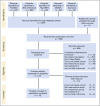Patient Navigation in Breast Cancer Treatment and Survivorship: A Systematic Review
- PMID: 27458298
- PMCID: PMC5065113
- DOI: 10.1200/JCO.2016.67.5454
Patient Navigation in Breast Cancer Treatment and Survivorship: A Systematic Review
Abstract
Purpose: Patient navigation is an intervention approach that improves cancer outcomes by reducing barriers and facilitating timely access to cancer care. Little is known about the benefits of patient navigation during breast cancer treatment and survivorship. This systematic review evaluates the efficacy of patient navigation in improving treatment and survivorship outcomes in women with breast cancer.
Methods: The review included experimental and quasi-experimental studies of patient navigation programs that target breast cancer treatment and breast cancer survivorship. Articles were systematically obtained through electronic database searches of PubMed/MEDLINE, PsycINFO, Web of Science, CINAHL, and Cochrane Library. The Effective Public Health Practice Project Quality Assessment Tool was used to evaluate the methodologic quality of individual studies.
Results: Thirteen studies met the inclusion criteria. Most were of moderate to high quality. Outcomes targeted included timeliness of treatment initiation, adherence to cancer treatment, and adherence to post-treatment surveillance mammography. Heterogeneity of outcome assessments precluded a meta-analysis. Overall, results demonstrated that patient navigation increases surveillance mammography rates, but only minimal evidence was found with regard to its effectiveness in improving breast cancer treatment outcomes.
Conclusion: This study is the most comprehensive systematic review of patient navigation research focused on improving breast cancer treatment and survivorship. Minimal research has indicated that patient navigation may be effective for post-treatment surveillance; however, more studies are needed to draw definitive conclusions about the efficacy of patient navigation during and after cancer treatment.
Conflict of interest statement
Authors’ disclosures of potential conflicts of interest are found in the article online at
Figures
Similar articles
-
The effectiveness of internet-based e-learning on clinician behavior and patient outcomes: a systematic review protocol.JBI Database System Rev Implement Rep. 2015 Jan;13(1):52-64. doi: 10.11124/jbisrir-2015-1919. JBI Database System Rev Implement Rep. 2015. PMID: 26447007
-
Experiences and meaningfulness of breast cancer survivorship care in improving the quality of life of immigrant women: A qualitative systematic review.Can Oncol Nurs J. 2024 Jul 1;34(3):304-356. doi: 10.5737/23688076343304. eCollection 2024 Summer. Can Oncol Nurs J. 2024. PMID: 39502095 Free PMC article.
-
Economic evaluation of patient navigation programs in colorectal cancer care, a systematic review.Health Econ Rev. 2018 Jun 14;8(1):12. doi: 10.1186/s13561-018-0196-4. Health Econ Rev. 2018. PMID: 29904805 Free PMC article. Review.
-
How has the impact of 'care pathway technologies' on service integration in stroke care been measured and what is the strength of the evidence to support their effectiveness in this respect?Int J Evid Based Healthc. 2008 Mar;6(1):78-110. doi: 10.1111/j.1744-1609.2007.00098.x. Int J Evid Based Healthc. 2008. PMID: 21631815
-
Web based survivorship interventions for women with breast cancer: An integrative review.Eur J Oncol Nurs. 2016 Dec;25:90-99. doi: 10.1016/j.ejon.2016.10.004. Epub 2016 Nov 4. Eur J Oncol Nurs. 2016. PMID: 27865259 Review.
Cited by
-
Practical Consensus Recommendations for Optimizing Risk versus Benefit of Chemotherapy in Patients with HR Positive Her2 Negative Early Breast Cancer in India.South Asian J Cancer. 2021 Dec 31;10(4):213-219. doi: 10.1055/s-0041-1742080. eCollection 2021 Dec. South Asian J Cancer. 2021. PMID: 34984198 Free PMC article.
-
Perspectives of multisectoral community stakeholders on Arab American cancer patients' needs and suggested interventions.Support Care Cancer. 2021 Oct;29(10):5915-5925. doi: 10.1007/s00520-021-06169-x. Epub 2021 Mar 24. Support Care Cancer. 2021. PMID: 33763724
-
A conceptual model of social networks and mechanisms of cancer mortality, and potential strategies to improve survival.Transl Behav Med. 2018 Jul 17;8(4):629-642. doi: 10.1093/tbm/ibx061. Transl Behav Med. 2018. PMID: 30016520 Free PMC article. Review.
-
Patient navigation to address sociolegal barriers for patients with cancer: A comparative-effectiveness study.Cancer. 2022 Jul 1;128 Suppl 13(Suppl 13):2623-2635. doi: 10.1002/cncr.33965. Cancer. 2022. PMID: 35699610 Free PMC article. Clinical Trial.
-
Patient Navigation for Timely, Guideline-Adherent Adjuvant Therapy for Head and Neck Cancer: A National Landscape Analysis.J Natl Compr Canc Netw. 2023 Dec;21(12):1251-1259.e5. doi: 10.6004/jnccn.2023.7061. J Natl Compr Canc Netw. 2023. PMID: 38081134 Free PMC article.
References
-
- Brawley OW, Berger MZ: Cancer and disparities in health: Perspectives on health statistics and research questions. Cancer 113:1744-1754, 2008 (suppl 7) - PubMed
-
- Byers T. Two decades of declining cancer mortality: Progress with disparity. Annu Rev Public Health. 2010;31:121–132. - PubMed
-
- Dohan D, Schrag D. Using navigators to improve care of underserved patients: Current practices and approaches. Cancer. 2005;104:848–855. - PubMed
-
- Mandelblatt JS, Yabroff KR, Kerner JF. Equitable access to cancer services: A review of barriers to quality care. Cancer. 1999;86:2378–2390. - PubMed
-
- Yabroff KR, Washington KS, Leader A, et al. Is the promise of cancer-screening programs being compromised? Quality of follow-up care after abnormal screening results. Med Care Res Rev. 2003;60:294–331. - PubMed
Grants and funding
LinkOut - more resources
Full Text Sources
Other Literature Sources
Miscellaneous


